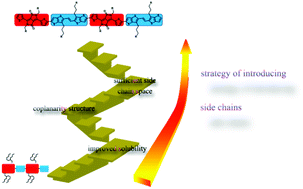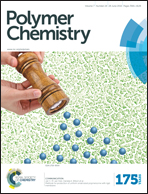Approaching high charge carrier mobility by alkylating both donor and acceptor units at the optimized position in conjugated polymers†
Abstract
Flexible side chains have been the central issue in the design of solution-processable polymer semiconducting materials. On identical conjugated backbones, great differences can be made with different side chain densities and substitution positions. Generally, for donor–acceptor (D–A) copolymers, increasing the side chain density could readily improve the solubility of the polymers. However, it also results in backbone distortion and weaker interchain interactions, thus hindering charge transport, which limits the application of highly soluble D–A polymers. Herein, we synthesized two polymers of PD-n-DTTE-7 with both the moieties alkylated. Substituting side chains to DTTE units improved the solubility of the corresponding polymers. Induced by the promoted solubility, high purity of the high molecular weight component was obtained and uniform films were formed with these high molecular weight polymers. In addition, by carefully selecting the conjugation system and substitution positions, ordered packing and backbone coplanarity were also achieved, which facilitate interchain and intrachain charge transport. Through a simple spin coating technique, the polymers, PD-n-DTTE-7s, present the highest hole mobility of 9.54 cm2 V−1 s−1 with high average mobilities of over 5 cm2 V−1 s−1, which are among the highest values for polymer-based field-effect transistors.


 Please wait while we load your content...
Please wait while we load your content...